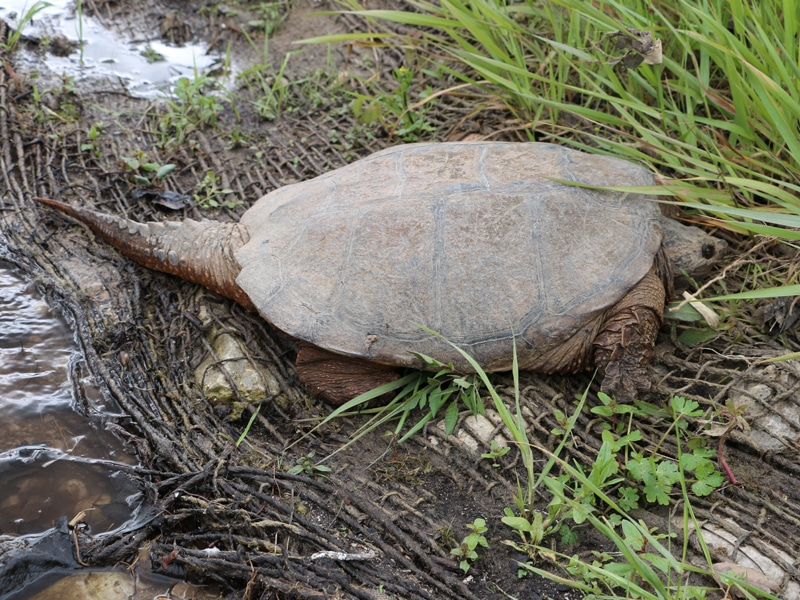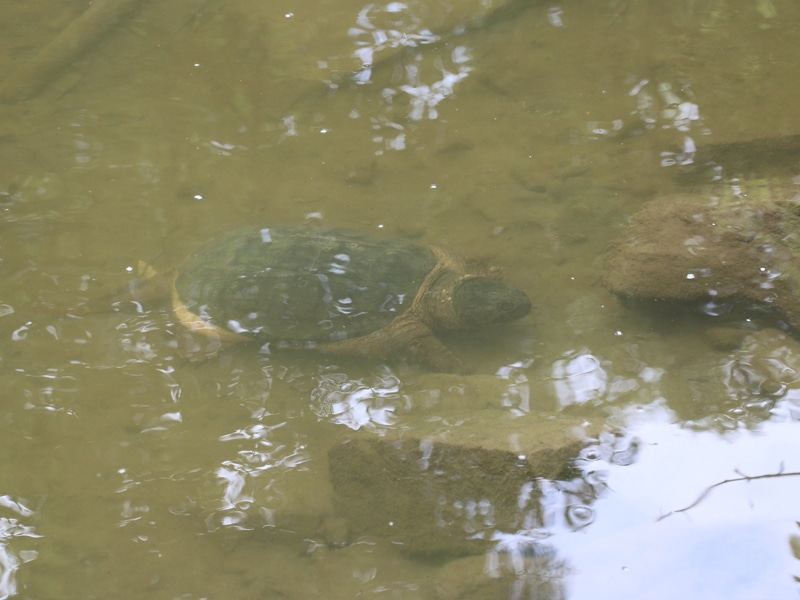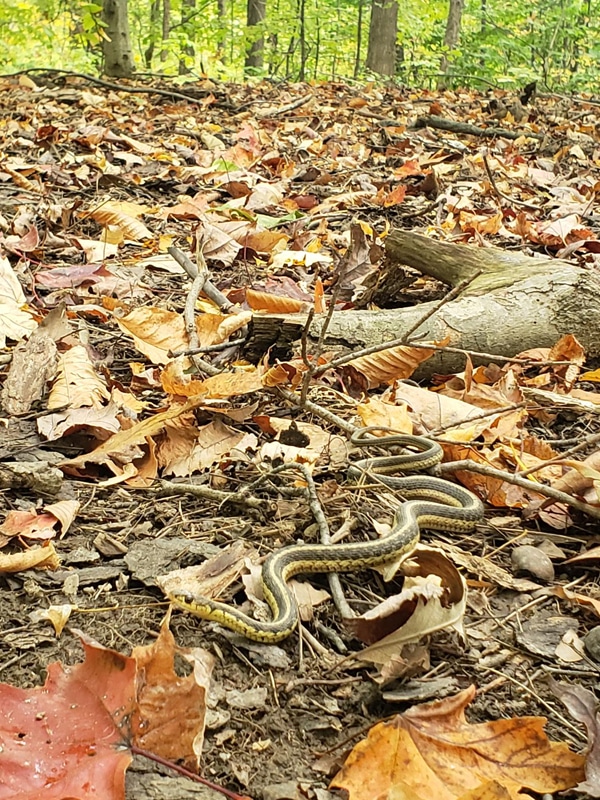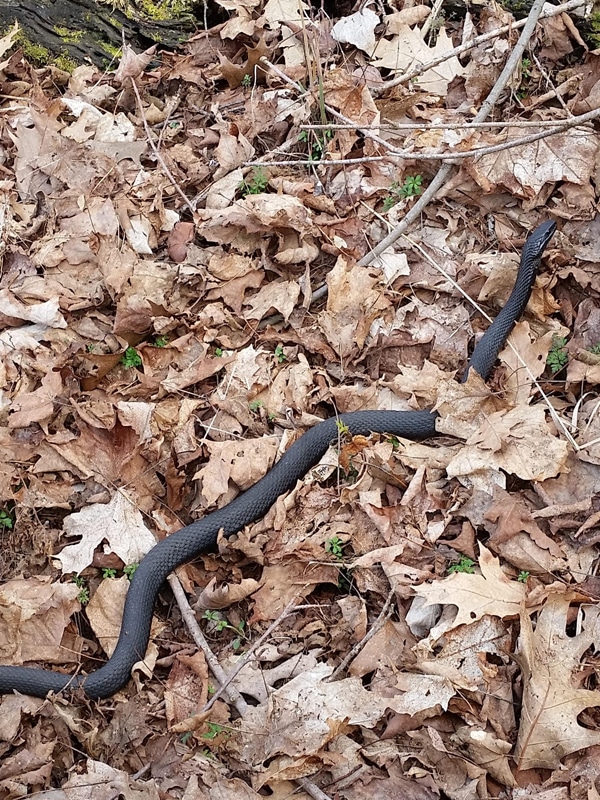Ever wonder what happens to all the reptiles and amphibians in our area during the winter? You probably knew they hibernate, but more specifically where do they hibernate and how do they do it? Most importantly, what is a frogsicle?!
We’ll cover where the turtles, snakes, frogs and toads, and salamanders go during the winter months, but first there are some important terms to know.
Important Terms
Turtles
 Snapping Turtle
Snapping Turtle Snapping Turtle Underwater
Snapping Turtle Underwater
Turtles hibernate in the bottoms of ponds and lakes deep in mud substrate. They bury themselves below the frost line where water doesn’t freeze. Since shallow ponds and bodies of water can freeze solid to the bottom in the right conditions, turtles will seek out deeper waters to avoid this.
When do they begin to hibernate?
Typically in October when the temperatures drop and stay colder. Warm spells during the fall will allow turtles (and other reptiles/amphibians) to maintain their body temperature and metabolism, so some may still be active if the weather is warm enough
When do they come out?
When temperatures increase and the water warms up; typically in March to April.
How do they hibernate?
After burying themselves in substrate, the cold temperatures cause their body temperature to drop which effects their metabolism. A lower body temperature slows their metabolism and in turn, less energy is needed to maintain bodily functions and stay alive.
Since they are underwater they do not have access to surface oxygen; turtles have two special ways of getting oxygen from water using blood vessel rich tissues in their throat and cloaca – simply put, their ‘butt’! They can absorb oxygen from the water and expel carbon dioxide from their bodies via gas exchange through these tissues.
The scientific term for breathing through their butt is called ‘cloacal respiration’ and breathing through their throat is called ‘buccopharyngeal respiration’. Frogs and salamanders can do this too!
Snakes
 Eastern Garter Snake
Eastern Garter Snake Melanistic Eastern Garter snake
Melanistic Eastern Garter snake
Into underground dens, caves and burrows called ‘hibernacula’. Snakes will make their own, or will use natural retreats or old burrows made by other animals. Most hibernacula have southern exposure and are close to the water table so that snakes have access to water, and the proper microclimates to facilitate hibernation (right oxygen and temperature).
When do they begin to hibernate?
Snakes will begin their hibernation sometime in the fall and can be anywhere from September to early November, depending on the weather.
When do they come out?
Snakes will emerge in the spring and again is dependent on weather but will be sometimes from April to early May. The habit of the pictured Garter Snake is for the males to exit first, and then wait around the Hibernaculum until the females emerge. It is at this point mating will ensue.
How do they hibernate?
Technically, snakes don’t hibernate since they do not go into a deep stasis and will remain semi-active in their hibernacula in a low conscious state. Similar to how bears hibernate; they don’t sleep through the whole winter.
Snakes often congregate in these hibernacula because the special conditions are difficult to find. They also are able to keep warm by staying together in a bundle. Different species have different preferences for hibernating (social vs. solitary locations), but Garter snakes do gather to hibernate in groups.
Frogs and Toads (Anurans)
 Gray Treefrog
Gray Treefrog
Most frogs hibernate in the water, in similar methods to turtles. Wood frogs, Chorus frogs and the Spring Peeper will hibernate in leaf litter, and is it’s good to leave the leaves in the fall.
Toads hibernate on land in burrows that often 50cm deep, putting them below the frost line.
When do they begin to hibernate?
Like other species in this blog, frogs and toads will hibernate in the fall when temperatures drop.
When do they come out?
Once the temperatures are warm enough they will emerge in the spring. A really cool video of this can be seen here!
How do they hibernate?
Most species avoid freezing by finding suitable shelter, however, three species in Ontario (Wood Frog, Spring Peeper, Chorus Frog) have adapted to be able to freeze! They can produce natural antifreeze in their blood from glucose and glycogen. This antifreeze prevents all the water content in their cells from freezing and causing damage to their cells and organs. Their hearts will stop beating, and they stop breathing, and brain functions cease. They go into a state of suspended animation and may appear like they’re dead. Up to 70% of their body can freeze solid turning them into frogsicles! They will then thaw out in the spring and are good to go!
Salamanders
 Red-Backed Salamander
Red-Backed Salamander
Terrestrial salamanders use old rodent burrows, cracks in rocks, log piles and compost heaps – anywhere they can avoid freezing. Mole salamanders (e.g. Ambystoma species) live underground year round, so they will move deeper into their burrows for winter. Aquatic salamanders (e.g. mudpuppies)they are active year round, even in the winter.
All salamanders are said to be tolerant to cold temperatures.
When do they begin to hibernate?
In the fall, typically October or the onset of cold weather.
When do they come out?
Early spring, from late March to early April. Salamanders will migrate to breeding pools, often when snow is still present.
How do they hibernate?
Little is known about how salamanders hibernate. Mole salamanders are very cryptic as they spend most of their time underground and are noctournal. They are difficult to observe so little is known about their behaviour. Eastern Red-backed salamanders are known to hibernate with their mate
- The typical heart rate of a turtle is 40 beats per minute, during hibernation it slows to 1 beat per 10 minutes!
- All North American reptiles cannot efficiently metabolize food under 16°C.
- Eastern Gartersnakes are the most commonly found snake in Ontario and are active at a wider range of temperatures than other species.
References and links for more information:
- https://www.reconnectwithnature.org/news-events/the-buzz/nature-curiosity-how-turtles-breathe-underwater
- https://adoptapond.wordpress.com/2013/01/04/winter-is-here-and-many-of-you-may-be-wondering-how-does-a-cold-blooded-reptile-like-a-turtle-survive-canadas-winter-months/#:~:text=Hibernation%20for%20Ontario’s%20turtles%20begins,whereas%20cold%20slows%20it%20down.
- https://ontarioturtle.ca/2009/01/winter-slumber/
- http://canadianherpetology.ca/conservation/doc/MNRF%20Snake%20Habitat%20BMP_final-1.pdf
- https://www.ontarioparks.com/parksblog/slithering-into-fall-hibernation-for-ontarios-reptiles/







